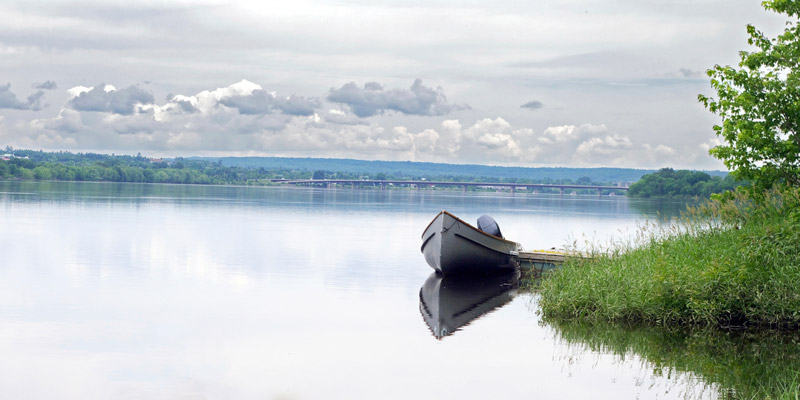More Value from the Same Water: Maximizing Water’s Sustainable Contribution to the Canadian Economy
Principal Investigator - Diane Dupont, Professor, Department of Economics; Brock University, 2008 - 2012

Challenge
Climate change has the potential to have severe impacts on water supply, thus Canadians must use their water in efficient and sustainable ways. However, these efforts have been previously hampered by an absence of economic data on water use and valuation. This project, led by Dr. Diane Dupont, shed light on the economic forces shaping water use, and identified policies and regulations to increase the efficiency of use and water’s potential contribution to the Canadian economy.
The project objectives included: 1) Increasing the knowledge on factors governing current water use by firms (particularly, agricultural) and households, and their valuations of water quantity and quality. This involves examining decisions regarding adoption of water-conserving technology and choices of water substitutes by households concerned about risks from diminished water quality; 2) Improving water demand forecasting to predict future water demand scenarios; 3) Translating knowledge regarding estimated water demands and values, the design of efficient water prices, efficient provincial allocation rules and water demand forecasting methods to partners and end users.
Project
The research took a multi-disciplinary approach that incorporated economics, economic geography and engineering. The work began by examining the structure of the basic behavioural relationships (such as water demands and adoption of water‐using technologies) that govern water use in the primary water‐using sectors in Canada. This involved econometric estimation of water demand/technology adoption models for both residential and industrial sectors, and collection of data via surveys and from partners. One example involved development of a joint irrigation water demand and technology adoption model for agriculture, where the team analyzed the circumstances and perceptions around farmer adoption of more efficient irrigation technology and management practices, and the impact of subsidy programs. The team developed methods to measure crop water demands and developed best practices for water savings – maximizing crop yields while conserving water. Another example incorporated surveys of household’s attitudes, degree of acceptance and views on health risks of using reclaimed wastewater.
The work also involved understanding and designing incentive structures, such as municipal water prices. The team modeled municipal water demands by partnering with several cities. One component of the project involved preparing a water demand forecasting report for York Region in Ontario. These models allow for improved signals of the costs of water use, promoting efficient water use and investment in water-conserving technologies. The work also provided new understanding of households’ decision-making regarding water-saving retrofits and water filter/bottled water purchases. Both water price increases and non-price conservation approaches increase the likelihood of household adoption of low-flow toilets and showers. Consumer concerns and perceptions about the presence of contaminants in water lead to spending to self-protect. Such expenditures exceed half a billion dollars annually.
After carrying out the first comprehensive assessment of the value of water in Canada in 25 years, a national picture of what is known regarding the value of water to Canada has emerged. Broadly speaking, it was found that agricultural and industrial applications of water are not as valuable as previously thought while preserving wetlands and instream flows are more valuable than currently thought.
Outputs
- Development of a drip line irrigation system that includes sensors and software that measure how much water is needed for irrigation. Prior to the sensor/software tool being developed, water needs were subjectively determined. The computer model developed employs an easy, graphical interface using real time measures allowing farmers to know when to turn on/off irrigation.
- Farmers have seen improvements in yields using the model in conjunction with surface driplines.
- In another case, a farmer has integrated GPS technology to line up plants with buried drip lines. As a result, less water is being used and higher yields are being realized.
- Project resulted in WEPGN receiving $2.31 million from Social Sciences and Humanities Research Council (SSHRC) to answer issues for different groups.
- Expert working group developed the guidelines for a Royal Institute of Chartered Surveyors Valuation Standards document. This document is a valuation method for water that is used for regulatory purposes such as lending, accounting and appraisal, and has been adopted by the Institute to guide its 140,000 members worldwide
This project has several end-user reports:
- Renzetti, Dupont, Wood (2011) Running Through Our Fingers. For Blue Economy Initiative.
- Brandes, Renzetti, Stinchcombe (2010) “Worth Every Penny: A Primer on Conservation-Oriented Water Pricing” POLIS Project, Victoria.
- Bjornlund (2010) “The Competition for Water: Striking a Balance among Social, Environmental and Economic Needs” C.D. Howe, Toronto.
- Dupont (2010) “Bottle Matters” Water Canada, November/December.
- Renzetti (2009) “Wave of the Future: The Case for Smarter Water Pricing” C.D. Howe, Toronto. Recognized in BDO Dunwoody Weekly CEO/Business Leader Poll.
- (2009) “Sustainable Management of Groundwater in Canada” For Council of Canadian Academies, Ottawa (Renzetti was expert panel member).
Outcomes
- Increased knowledge surrounding the value of water to Canada.
- Advice and elasticity estimates supported the National Round Table on Environment and Economy (NRTEE) efforts to forecast water use in natural resource industries and to conduct simulations regarding the impacts (on costs and water use) of introducing water abstraction fees for these industries. http://www.blue-economy.ca/sites/default/files/reports/charting-a-course-eng.pdf
- Informed decision-making related to capital spending, for municipalities due to additional and necessary information.
- Tomato farmers in Leamington, ON were informed about precision irrigation and invested in sensors/software for surface drip lines.
- Increased awareness of the role that water value plays in water management.
- Implementation of GIS techniques with water consumption information, allowing for the use of statistics Canada Census data to further refine water demand modeling and forecasting.
- Adoption of new valuation framework for water to guide worldwide members (Royal Institute of Chartered Surveyors, London).
- Informed pricing decisions that will contribute to slowed demand growth and lowered capital infrastructure.
- Increased capacity for consulting firms to undertake water valuation survey work.





